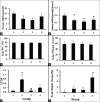N-acetylcysteine Prevents Kidney and Lung Disturbances in Renal Ischemia/Reperfusion Injury in Rat
- PMID: 24319553
- PMCID: PMC3843300
N-acetylcysteine Prevents Kidney and Lung Disturbances in Renal Ischemia/Reperfusion Injury in Rat
Abstract
Background: One of the most common causes of acute kidney injury (AKI) is kidney ischemia/reperfusion injury (IRI). The distant organ injury such as acute lung injury is one of the side effects of AKI or kidney IRI. In this study, we performed bilateral renal IRI in rats and the protective role of N-acetylcysteine (NAC) in kidney and lung was investigated.
Methods: Rats (n = 30) were randomly assigned to four experiment groups. The group 1 was assigned as sham-operated group. Before kidney IRI performance, the others groups were treated with saline (group 2), 150 mg/kg (group 3) or 500 mg/kg (group 4) of NAC, and the treatment were continued daily after IRI for next 3 days. At day 3, the all groups' animals were subjected for the measurements.
Results: The serum level of blood urea nitrogen (BUN) and creatinine (Cr) in the control group increased significantly (P < 0.05), and administration of NAC (150 mg/kg) decreased the serum levels of Cr and BUN. However, only the serum level of Cr decreased significantly (P < 0.05). NAC did not improve kidney weight and damage; however, its low dose (150 mg/kg) attenuated the lung injury score (P < 0.05) when compared with the control group. No significant differences were observed in lung water content and endothelial permeability, serum levels of malondialdehyde and nitrite between the groups.
Conclusions: Low dose of NAC as a protectant agent may protect the kidney function and lung tissue damage after kidney IRI.
Keywords: Kidney; NAC; lung endothelial permeability; lung water content; rat; renal IRI.
Conflict of interest statement
Figures



References
-
- Awad AS, Okusa MD. Distant organ injury following acute kidney injury. Am J Physiol Renal Physiol. 2007;293:F28–9. - PubMed
-
- Deng J, Hu X, Yuen PS, Star RA. α-Melanocyte-stimulating hormone inhibits lung injury after renal ischemia/reperfusion. Am J Respir Crit Care Med. 2004;169:749–56. - PubMed
-
- Doi K, Ishizu T, Fujita T, Noiri E. Lung injury following acute kidney injury: Kidney-lung crosstalk. Clin Exp Nephrol. 2011;15:464–70. - PubMed
-
- Li X, Hassoun HT, Santora R, Rabb H. Organ crosstalk: The role of the kidney. Curr Opin Crit Care. 2009;15:481–7. - PubMed
LinkOut - more resources
Full Text Sources
